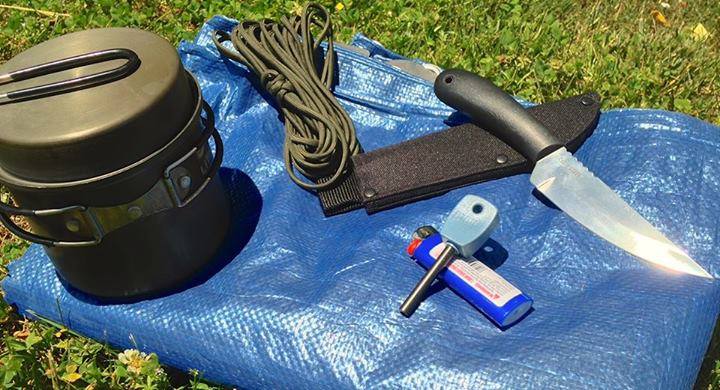The Five C’s of Survival

By: John Anderson
Imagine a great day chasing elk in the early winter. You hiked in solo and just bagged a monster late in the day, but after tracking it down, it’s dark and cold. A winter storm is fast approaching and you’ve got little choice; you’re stuck out in it tonight. Are you prepared? Do you have the tools in your kit and the knowledge to use them to survive?
I’m John Anderson and this is the newest addition to Takedown Outdoors: Wilderness Self-Reliance. I have always had a love for the outdoors, like many of you, and I was raised hunting and fishing with my father. I have a career in technology which has led me far from the woods on a daily basis, so I jump at the opportunity to get out into nature. Acquiring these skills has been the product of a desire to regain the ancient paths that our forefathers walked. Let’s learn together what it takes to survive when the unforeseen becomes your reality.
I have found, if you think ahead and prepare for the distinct possibility that things may not go according to plan, you can do a lot to affect your survivability in any wilderness situation. There are five categories of gear that can help you in this preparation, and combined with the understanding of how to use them, they’ll make the difference that will give you the confidence to never again fear a long night in the woods.
FIVE C’S OF SURVIVAL
- Cutting Tool
- Combustion
- Cover
- Container
- Cordage
Remember, in survival, the name of the game is conserving energy, so you can spend it on getting rescued instead of on keeping alive. Each one of these tools grants you a huge gain in efficiency, allowing you to do things in the woods that you’d struggle to accomplish without them, thus saving you valuable time and energy.
CUTTING TOOL
Whenever you go into the woods, a knife of some kind is a must. The kind of knife you choose may vary, but any cutting tool is better than nothing. This blade will give you the ability to improvise many other things that will help you survive, like making a fire or building a shelter. You’d be hard pressed to reproduce a good cutting tool in the wilderness, so you’d better bring one in with you. A fixed-blade knife with a good, sharp blade and a hard edge on the spine for striking a fire-starter is highly recommended.
COMBUSTION
When you’re stuck in the woods, the first thing you want is fire. With fire, you can purify water, you can cook food, you can see at night, and you can ward off any animals that might want to eat you for supper. There are dozens of ways to make fire and it’s a good idea to know several of them. However, the best fire is the one you can make with the least amount of energy and time expended. Carrying a few options for creating fire will give you redundancies, in case of wet conditions, loss of a bag, or failure of your trusty Bic. A simple butane lighter is a great first option, and if you have an inexpensive ferrocerium rod (like the flint in your lighter, but much bigger and thicker) and a hard edge on the back your knife, combined with some practice, you’re going to be able to produce fire. Packing along some dry tinder material, such as cotton balls, dryer lint, or commercial fire-starting tinder, makes the process go that much more smoothly.
COVER
Yes, one can build a shelter in the woods using nothing but natural materials, but how much energy will you save if you brought along some cover? This could be as simple as a small tarp, a 100% wool blanket, or even a large garbage bag. This piece of cover, either on its own or when integrated into a shelter you build, will help you stay alive and comfortable by conserving body heat, keeping you dry and out of the wind, and acts as a sun shade to keep you from rapid dehydration.
CONTAINER
You’ve got to drink water, or you’ll die. You can go quite a long time without food, but a day or two without water will seriously disable you. When you’re in a wilderness situation, any water you find is a potential source of hydration, but only if you can purify it. The simplest, most effective way to do that is by boiling it. In order to boil water, you’ll need some kind of metal container. If you had a small, lightweight pot with you, that would be ideal, but even an empty soup can or soft drink can is a good option.
CORDAGE
The ability to tie things up or bind things together is a great time and energy saver. Bringing a supply of 550 cord (paracord) with you on your next trip will enable you to more easily fashion a shelter, rig your tarp for a sunshade, create a tripod to cook your food over the fire or hang your pot for boiling water, improvise a sling to bind up a dislocated shoulder, replace a broken shoelace, and so many other practical, helpful tasks. It weighs next to nothing, takes little room, and is inexpensive. You’ll never say to yourself, “I wish I didn’t have this extra cordage with me.”
Each one of these five categories of gear will greatly aid you in surviving an unexpected emergency. Together, they form the basis of a survival mentality that offers you something even more valuable: confidence. In coming issues of the newsletter, we’ll dive into each category in detail, but for now, if you want to go deeper and learn more, I highly recommend you check out this excellent beginner video from Dave Canterbury from the Pathfinder School.

John Anderson spent his youth in the woods of North Carolina and the jungles of South-east Asia. Having been raised by missionary parents, John has spent time in Mexico, Canada, and the Philippines, climbing trees, hunting game, and getting dirty. His father spent the time to teach him the ways of the woods, building fires, hunting deer, hiking, and camping. He received further training in the outdoors through the Outdoor Education program at Montreat College and from many trips on the trails and waterways of the Appalachian Mountains with his band of brothers.



